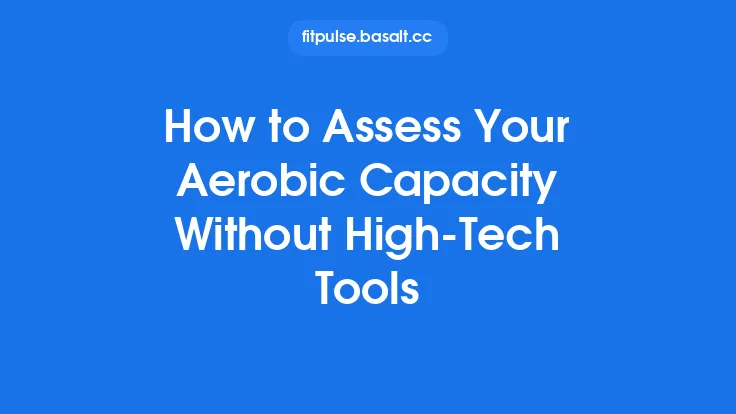VO₂ max – the maximal amount of oxygen your body can use during intense exercise – is one of the most powerful indicators of cardiovascular fitness. While the gold‑standard measurement involves a graded exercise test in a laboratory with a metabolic cart, most athletes and fitness enthusiasts never set foot in a lab. Fortunately, advances in wearable technology, smartphone apps, and well‑validated field protocols now make it possible to estimate VO₂ max with a high degree of reliability from the comfort of your own training environment.
Below is a comprehensive guide that walks you through the science, the tools, and the step‑by‑step procedures you can use to obtain an accurate VO₂ max estimate without ever needing a lab. The focus is on evergreen methods that remain relevant regardless of the latest gadget releases, ensuring you can apply these techniques for years to come.
Understanding the Basis of Non‑Lab VO₂ max Estimation
1. The Physiological Principle
VO₂ max is defined as the product of three variables:
- Cardiac Output (Q) – the volume of blood the heart pumps per minute.
- Arterial‑Venous Oxygen Difference (a‑vO₂ diff) – the amount of oxygen extracted by the muscles from each liter of blood.
- Maximum Heart Rate (HRₘₐₓ) – the highest heart rate an individual can achieve.
Mathematically:
\[
\text{VO₂ max} = Q \times a\text{-}vO₂\text{ diff}
\]
Because directly measuring Q and a‑vO₂ diff requires invasive equipment, non‑lab methods infer VO₂ max by observing how heart rate, speed, and power respond to a known workload. The underlying assumption is that, at a given intensity, the relationship between heart rate and oxygen consumption is linear for most healthy adults.
2. Why Field Estimates Can Be Accurate
- Large Data Sets: Modern wearables are calibrated using thousands of lab‑tested individuals, creating robust regression models.
- Individual Calibration: Many devices allow you to input personal data (age, weight, gender) and, optionally, a short maximal effort test to fine‑tune the algorithm.
- Repeated Measures: Averaging multiple test results reduces random error and improves reliability.
Choosing the Right Tool for Your Situation
1. Wearable Sensors
| Device Type | Primary Data Collected | Typical Accuracy (±) | Ideal Use Case |
|---|---|---|---|
| Chest‑strap HR monitor (e.g., Polar H10) | Precise heart rate, optional speed via bike/speed sensor | ±2 bpm | Running or cycling where HR is the main variable |
| Wrist‑based optical HR (e.g., Apple Watch, Garmin) | Heart rate, accelerometer‑derived speed/power | ±5 bpm (depends on fit) | General fitness, convenience |
| Foot pod or bike power meter | Speed or power, paired with HR monitor | ±1–2 % for speed, ±1 % for power | Precise pacing for treadmill or bike tests |
| Smartphone apps with GPS | Speed, distance, elevation | ±3–5 % (GPS variance) | Outdoor runs where a dedicated device isn’t available |
Tip: For the most accurate VO₂ max estimate, combine a reliable heart‑rate source (chest strap) with a direct measurement of external work (speed on a treadmill or power on a bike). This dual‑input approach reduces reliance on GPS or accelerometer noise.
2. Software & Algorithms
- Proprietary Algorithms: Brands like Garmin, Polar, and Suunto embed VO₂ max estimation directly into their platforms. They typically require a minimum number of recorded activities (e.g., 5–10 runs) before providing a value.
- Open‑Source Models: Researchers have published regression equations that can be implemented in spreadsheet software or custom apps. Examples include the Cooper 12‑Minute Run Test formula and the Uth–Sørensen treadmill protocol.
- Hybrid Approaches: Some platforms let you upload raw HR and speed data to third‑party calculators (e.g., TrainingPeaks VO₂ max calculator) for a more transparent view of the underlying math.
Proven Field Tests for Estimating VO₂ max
Below are three widely accepted protocols that can be performed with minimal equipment. Each test includes a brief description, required gear, step‑by‑step instructions, and the calculation method.
1. The 12‑Minute Run (Cooper Test)
Purpose: Estimate VO₂ max based on the distance covered in 12 minutes of maximal effort running.
Equipment Needed: Stopwatch, measured flat course (track or calibrated treadmill), optional heart‑rate monitor for post‑test verification.
Procedure:
- Warm up for 10–15 minutes with easy jogging and dynamic stretches.
- Begin the timer and run as far as possible for exactly 12 minutes. Maintain a steady, hard pace; avoid sprinting at the start.
- Record the total distance (in meters) covered.
Calculation:
\[
\text{VO₂ max (ml·kg⁻¹·min⁻¹)} = \frac{\text{Distance (m)} - 504.9}{44.73}
\]
Example: If you run 3,000 m, VO₂ max ≈ (3000 – 504.9) / 44.73 ≈ 55.7 ml·kg⁻¹·min⁻¹.
Accuracy Considerations:
- Best suited for runners familiar with pacing.
- Terrain and wind can introduce error; a track eliminates most variables.
- The formula assumes a linear relationship between speed and VO₂ max, which holds true for most recreational athletes.
2. Submaximal Treadmill Test (Uth–Sørensen Protocol)
Purpose: Derive VO₂ max from heart‑rate responses to incremental treadmill speeds at a fixed grade.
Equipment Needed: Treadmill with speed control, reliable chest‑strap HR monitor, stopwatch.
Protocol Overview:
- Stage 1: 5 min at 5 km/h (3.1 mph) – warm‑up.
- Stage 2: Increase speed by 1 km/h every 2 minutes while maintaining a 0 % grade.
- Continue until HR reaches 85 % of estimated HRₘₐₓ (HRₘₐₓ ≈ 220 – age) or you cannot maintain the speed.
Data Collection:
- Record steady‑state HR (last 30 seconds) and corresponding speed for each stage.
Calculation Steps:
- Plot speed (x‑axis) vs. HR (y‑axis) for all submaximal stages.
- Perform linear regression to obtain the slope (m) and intercept (b) of the line: HR = m·speed + b.
- Extrapolate to HRₘₐₓ (or 200 bpm if HRₘₐₓ is unknown) to find the speed at maximal effort:
\[
\text{Speed}{\text{max}} = \frac{HR{\text{max}} - b}{m}
\]
- Convert the maximal speed to VO₂ max using the ACSM running equation (for 0 % grade):
\[
\text{VO₂ max} = 0.2 \times \text{Speed}{\text{max}} + 0.9 \times \text{Speed}{\text{max}} \times \text{Grade} + 3.5
\]
(Speed in m·min⁻¹; for 0 % grade the second term drops out.)
Why It Works:
The linear HR‑speed relationship holds up to about 85 % of HRₘₐₓ. By extrapolating, you estimate the speed you could sustain at true maximal effort, which directly translates to VO₂ max.
Practical Tips:
- Ensure the treadmill is calibrated; a 1 km/h error can shift VO₂ max by ~0.5 ml·kg⁻¹·min⁻¹.
- Keep environmental conditions (temperature, humidity) consistent across tests.
3. The 3‑Minute All‑Out Cycling Test (Power‑Based)
Purpose: Estimate VO₂ max from the average power output during a maximal 3‑minute effort on a calibrated bike trainer or smart trainer.
Equipment Needed: Smart bike trainer or power meter, chest‑strap HR monitor (optional), cycling computer or app that records power.
Protocol:
- Warm up for 10 minutes, including 2–3 short (15‑second) sprints to prime the neuromuscular system.
- Begin a 3‑minute timer and ride at the highest sustainable cadence and resistance you can maintain for the full duration. Aim for a smooth, steady effort rather than a start‑stop sprint.
- Record the average power (watts) over the 3‑minute window.
Calculation (using the Jones et al. equation):
\[
\text{VO₂ max (ml·kg⁻¹·min⁻¹)} = \frac{( \text{Average Power (W)} \times 10.8 )}{\text{Body Mass (kg)}} + 7
\]
Example: Average power = 250 W, body mass = 75 kg → VO₂ max ≈ (250 × 10.8 / 75) + 7 ≈ 43 ml·kg⁻¹·min⁻¹.
Key Points:
- Power meters provide a direct measure of external work, eliminating the need to estimate speed or grade.
- The test is less affected by environmental variables (wind, temperature) than running protocols.
- Consistency in cadence (≈90 rpm) improves repeatability.
Enhancing Accuracy: Best Practices Across All Methods
- Standardize Pre‑Test Conditions
- Avoid heavy meals, caffeine, or alcohol for at least 2 hours before testing.
- Ensure you are well‑hydrated and have had 7–9 hours of sleep.
- Perform the test at the same time of day (morning vs. evening can affect HR and temperature).
- Use a Consistent Warm‑Up
- A 10‑minute progressive warm‑up (gradually increasing intensity) prepares the cardiovascular system and reduces the risk of early fatigue.
- Record Multiple Sessions
- Conduct the chosen test 2–3 times over a 2‑week period. Average the resulting VO₂ max values to smooth out day‑to‑day variability.
- Validate with Heart‑Rate Data
- Even if the primary metric is distance or power, capture heart‑rate data. If your HR at the end of the test is far below the expected percentage of HRₘₐₓ, the effort may not have been maximal.
- Account for Body Mass Changes
- VO₂ max is expressed per kilogram of body weight. If you are actively losing or gaining weight, recalculate using the current mass to keep the metric meaningful.
- Consider Equipment Calibration
- Treadmills, bike trainers, and power meters can drift over time. Follow the manufacturer’s calibration routine before each testing session.
Interpreting the Result: From Number to Action
While the article deliberately avoids detailed benchmark tables (to stay clear of the “VO₂ max Benchmarks” neighboring article), it is still useful to understand the practical implications of your estimate.
- Relative Changes Matter More Than Absolute Values: A 5 % increase in VO₂ max over a training cycle is a strong indicator of improved aerobic capacity, regardless of where you started.
- Trend Monitoring: Plot your VO₂ max estimates on a monthly basis. A gradual decline may signal insufficient training load, illness, or overreaching.
- Training Zones: Many modern training platforms can convert your VO₂ max estimate into personalized intensity zones (e.g., “Tempo” or “Threshold”). Use these zones to structure workouts that target specific physiological adaptations.
Common Pitfalls and How to Avoid Them
| Pitfall | Why It Reduces Accuracy | Mitigation |
|---|---|---|
| Running on a Hilly Course for the 12‑Minute Test | Elevation changes alter the oxygen cost of running, breaking the linear speed‑VO₂ relationship. | Use a flat track or treadmill; if outdoors, choose a straight, level route. |
| Relying Solely on Wrist‑Based HR for Submaximal Tests | Optical sensors can lag during rapid intensity changes, leading to erroneous HR readings. | Pair the wrist device with a chest strap, or use a dedicated HR monitor for the test. |
| Skipping the Warm‑Up | Incomplete cardiovascular priming can cause early HR drift, making the HR‑speed line less linear. | Always include a 10‑minute progressive warm‑up. |
| Testing When Ill or Sleep‑Deprived | Illness and fatigue lower maximal heart rate and power output, underestimating VO₂ max. | Reschedule the test; aim for a rested, healthy state. |
| Using Outdated Device Firmware | Algorithm updates can improve estimation models; old firmware may use less accurate equations. | Keep wearables and apps up to date. |
Future‑Proofing Your VO₂ max Tracking
Even though the methods described are fully functional today, the field of biometric monitoring continues to evolve. Here are a few trends to watch, ensuring your approach remains relevant:
- Machine‑Learning Personalization: Newer platforms train models on your individual data over time, refining VO₂ max estimates beyond generic population equations.
- Multi‑Sensor Fusion: Combining HR, skin temperature, and respiratory rate can improve the precision of oxygen‑consumption predictions.
- Cloud‑Based Validation: Some services now allow you to upload raw sensor data for expert review, providing a “virtual lab” check on your field results.
By staying aware of these developments, you can adopt newer tools as they become validated, while still relying on the solid, time‑tested field tests outlined above.
Quick Reference Checklist
- Select a test (12‑minute run, submax treadmill, 3‑minute cycling) that matches your preferred activity and available equipment.
- Gather reliable sensors (chest‑strap HR + speed/power source).
- Standardize pre‑test conditions (nutrition, sleep, time of day).
- Warm up for 10–15 minutes.
- Execute the test with maximal, steady effort.
- Record data (distance, speed, power, HR).
- Apply the appropriate formula or regression to calculate VO₂ max.
- Repeat 2–3 times and average the results.
- Track trends over weeks and months, adjusting training as needed.
With this systematic approach, you can obtain a trustworthy VO₂ max estimate without stepping into a laboratory, empowering you to make data‑driven decisions about your aerobic training and overall fitness journey.





